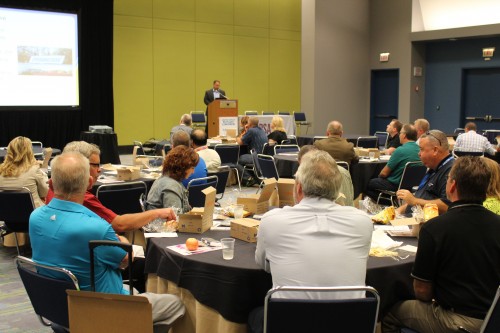Progressive's Seven-step Insourcing Journey
Headquartered in Cleveland, Progressive’s in-plant has 119 employees in two locations. With a $74 million annual budget, it produces 225 million impressions annually.
Still, Progressive was sending millions of dollars of creative print work outside the organization each year for processing and printing. The in-plant wanted to understand whether insourcing this work would improve cost management and job turnaround, so it undertook a thorough, analytical seven-step process to determine the optimal balance of internal and external production.
At Graph Expo, Tom Rohrbach, IT systems engineer consultant at Progressive, shared that process with a roomful of fellow in-plant managers during a special luncheon hosted by IPG and sponsored by Rochester Software Associates.
Rohrbach began by detailing how work comes into the in-plant. Jobs arrive from a variety of sources and automated feeds, he said. They flow through various design tools and postal preparation software, and then go through workflow and conversion or processing tools prior to being output on the shop’s offset presses and high-speed digital printers. After binding, jobs are shipped or warehoused.
About 85 percent of the in-plant’s volume comes from the transactional part of the operation, Rohrbach revealed. But the in-plant is part of the Creative Business Operation (CBO) team, which is responsible for everything from design through shipping. The CBO group produces marketing, promotional, advertising and corporate pieces. Nearly all of this creative work was being outsourced.
To determine whether insourcing this work would save money and improve turnaround times, the in-plant needed data. The company also wanted to maintain brand and data control, and enable vendor neutrality, Rohrbach added.
“Content ownership has become a real question at Progressive,” he said. “We need to take that content ownership back. We have the tools in-house to do that. We need to get better at using them.”
The Seven-step Process
The in-plant conducted a thorough seven-step analysis to determine the best balance of internal and external production:
- Define the insourcing opportunity. First the organization determined whether an opportunity existed and what its scale was. The in-plant used shop floor data and kept diving deeper and deeper into that data as questions arose, Rohrbach said.
- Establish the project mission. Progressive wanted to determine where jobs were produced and why, predict future customer needs and make recommendations to either maintain, outsource more or add internal capabilities.
- Determine the approach. Steps were identified that would answer the questions put forth in the mission.
- Define the current state. Progressive defined the capacity and utilization of hardware and software, conducting device-by-device process reviews. The complete flow of projects was examined. For external jobs, a similar review process was performed.
- Internal vs. external analysis. For each job, the in-plant considered whether it could be internally produced. If so, would internal capabilities need to be added or modified?
- Project customer needs and volumes. Customers were identified and prioritized by volume and project type. The in-plant determined whether projects were one-time or ongoing and identified future project types.
- Define future state. Progressive is currently at this stage, determining if procurement of additional or replacement equipment will enable producing outsourced work internally at a better cost with better service. The in-plant is also working on refining staffing and cost models in this step of the process.
The Importance of Data and Champions
Key lessons the in-plant took away from this exercise included: the importance of the data and IT support; the need for business champions to support the in-plant; and the importance of owning the brand.
According to Rohrbach, the real challenge is using the data from the analysis to project Progressive’s future. What the project has really brought about is what Progressive calls “right work, right place”—making sure work is being produced where it makes the most sense. A project team now looks at every project that comes in and makes this determination.
“This isn’t something you do one time; it’s something you need to continue to do over and over again as you work your processes,” Rohrbach told the audience. “In-plants face a constant challenge. At Progressive we have to continually prove that our existence is worthwhile. And what we have to offer is speed to market. We offer cost-competitive pricing. We have to continue to provide the business with the leverage to make us the best that we can be. We have to challenge ourselves.”













